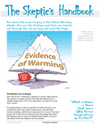|
|
By Jo Nova
The more CO2 we emit, the less we spend on global weather disasters
Fully half of all human emissions of CO2 ever, have been emitted since 1990. This super-molecule was supposed to cause stronger cyclones, nastier storms, more droughts, floods, sea level surges, blizzards, and fires. We were going to save a fortune by installing solar panels and windmills to reduce CO2 and slow the storms. Instead, we make more CO2 than ever, and 34 years of data suggests that the more we make the less we have to spend on flattened or flooded homes.
Munich Re says the world has experienced $298 billion dollars of catastrophic disaster losses due to weather events in 2024. This sounds terrible in terms of mindless “big numbers” , but Roger Pielke Jnr points out that these losses are shrinking in terms of the size of the global economy.
And they are nothing compared to the size of the dead end “transition” spending. Catastrophic weather losses in 2024 “were about 0.26% of global GDP.” We are rebuilding our entire energy system, supposedly to reduce the damage caused by climate change which that hurts one quarter of one percent of our global […]
Photo by Horacio_Fernandez
By Jo Nova
It was always the Posterchild Catastrophe of Doomsters, but two new studies suggest Easter Island might be (mostly) a story of remarkable human achievement instead.
In environmentalist legends, Easter Island was The Ecocide: they built nearly 1,000 giant stone statues but stupidly chopped down all its trees, and died in horrible wars. It was the sorry tale of ecological collapse and deforestation that we could tell small children at bedtime. After the last trees were sliced and diced, a catastrophe of horrors surely followed as the population of 15,000 people ran out of food and no one could make a boat to escape. Obsidian flakes across the island were interpreted as weapons of war and one anthropologist claimed there was a huge civil war that ended in the battle of 1680. Environmental hell on Earth was here…
But new research on the genomes of some islanders suggests that the population was probably small all along. When the Europeans arrived there were only about 3,000 people, and a genetic analysis suggests there are no signs of a recent collapse in the population. Another study of the fields suggests they made some very sophisticated […]
By Jo Nova
To solve the increase in global disasters just axe the UN
Despite a galactic rise in Headlines of Doom, the world is a safer place than ever. The United Nations however is an absolute danger to our quality of life and our children’s mental health. They’ve shamelessly concocted the myth that disasters are increasing due to “climate change”.
NetZeroWatch report on a new paper on natural disasters and find that yearly deaths are down. Somehow satellites, phones, antibiotics, bulldozers and fire trucks are better at saving lives than horse drawn carts and hessian bags. Who would have guessed, apart from everyone?
From Alimonti and Mariani.:
Below the graph of natural disaster events shows a huge increase in the reporting of disasters, at least up until the turn of the century. But there is, if anything, a decline since then. There are three very different trends. But the giant bureaucratic sponge that is the United Nations can shamelessly draw a straight linear trend through this graph and tell the world that disasters are getting worse, even as they are obviously not.
In the last twenty years, humans have put out 40% of all the CO2 emissions they’ve […]
By Jo Nova
If man-made climate change does anything at all, it makes Global Disasters tamer
Humans produced 980 billion tons of CO2 in the last 32 years, yet global losses due to weather related damage are shrinking as a proportion of our economy.
Despite there being more humans on Earth than ever before, with more buildings, farms, and factories just waiting to be wrecked by bad weather, somehow global weather disaster losses are not as large a part of our economy as they used to be.
All those extra houses, tractors and cars are sitting-ducks for storms, floods, and hailstones, yet the “climate crisis” is doing less damage to our GDP than it used to when CO2 levels were much lower.
Back in 1990 global CO2 levels were just 355ppm, now it’s more like 417ppm.
Roger Piekle Junior investigated the economic losses of weather disasters for the last three decades. He found that when losses were adjusted for inflation, and measured as a proportion of global GDP, damages were shrinking.
Naturally this tells us nothing at all about what drives the climate, but shows the prophesies are bonkers, and the relentless weather porn on the news is like […]
Multiple Cyclones, Fires, Floods and Heatwaves striking Australians at same rate for last 55 years
Gissing et al looked at insurance losses and plotted all the times multiple disasters piled up on each other in a three month period in Australian history. Despite the monster headlines and three quarters of all human CO2 emissions occurring since 1966 there was no trend.
Three new studies affirm there has been no significant change in natural disasters, precipitation, or bushfire across Australia for the last several decades.
Kenneth Richard, NoTricksZone
From the paper:
“Here we utilise an Australian natural disaster database of normalised insurance losses to show compound disasters are responsible for the highest seasonal financial losses. … There has been no temporal trend in their frequency since 1966. “
The predominant and most predictable driver of climate-related disaster events is not anthropogenic global warming, or CO2 emissions, but the El Niño Southern Oscillation.
Bad things happen:
Global levels of CO2 rose from 320 to 405ppm and made no difference to Compound disasters.
h/t Neville and El Gordo
REFERENCE
Gissing et al (2021) Compound natural disasters in Australia: a historical analysis, Environmental Hazards, […]
Hitting the presses today, the vacuous news that lots of companies picked huge numbers out of the air using broken models to guess hyperbolic climate losses coming in the next five years, counter to all the trends for the last hundred years which show declining losses on a GDP basis. The world got warmer but the disasters got less nasty. Less bushfire, less cyclones, less tornadoes, less death per capita. The trends are all good. The only thing that’s up is the number of panic merchants.
World’s biggest firms foresee $1 trillion climate cost hit
LONDON (Reuters) – More than 200 of the world’s largest listed companies forecast that climate change could cost them a combined total of almost $1 trillion, with much of the pain due in the next five years, according to a report published on Tuesday.
So hundreds of companies have offered the climate world a free hit for PR by making a guess. They fall into two kinds of companies –The badgered and harried and the profiteers. See below for examples. Firstly, here’s the only chart that matters.
Global Weather losses are down:
If CO2 causes climate events we need more of it. The […]
|
JoNova A science presenter, writer, speaker & former TV host; author of The Skeptic's Handbook (over 200,000 copies distributed & available in 15 languages).

Jo appreciates your support to help her keep doing what she does. This blog is funded by donations. Thanks!


 Follow Jo's Tweets
Follow Jo's Tweets To report "lost" comments or defamatory and offensive remarks, email the moderators at: support.jonova AT proton.me
Statistics
The nerds have the numbers on precious metals investments on the ASX
|












Recent Comments